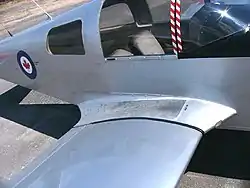Aircraft fairing
An aircraft fairing is a structure whose primary function is to produce a smooth outline and reduce drag.[1]

The wing root fairing of an American Aviation AA-1 Yankee
These structures are covers for gaps and spaces between parts of an aircraft to reduce form drag and interference drag, and to improve appearance.[1][2]

A cockpit fairing or "pod" with a windshield on a P&M GT450 ultralight trike

Spats on a Cessna Skylane 182T
.jpg.webp)
Dorsal fillets between fuselage and fin on Fokker Fk.28s

An aircraft wheel fairing, commonly called a wheel pant or spat or, by some manufacturers, a speed fairing
Types
On aircraft, fairings are commonly found on:
- Belly fairing
- Also called a "ventral fairing", it is located on the underside of the fuselage between the main wings. It can also cover additional cargo storage or fuel tanks.[3]
- Cockpit fairing
- Also called a "cockpit pod", it protects the crew on ultralight trikes. Commonly made from fiberglass, it may also incorporate a windshield.[4]
- Elevator and horizontal stabilizer tips
- Elevator and stabilizer tips fairings smooth out airflow at the tips.
- Engine cowlings
- Engine cowlings reduce parasitic drag by reducing the surface area, having a smooth surface and thus leading to laminar flow, and having a nose cone shape, which prevents early flow separation. The inlet and the nozzle in combination lead to an isotropic speed reduction around the cooling fins and due to the speed-squared law to a reduction in cooling drag.
- Fin and rudder tip fairings
- Fin and rudder tip fairings reduce drag at low angles of attack, but also reduce the stall angle, so the fairing of control surface tips depends on the application.[5]
- Fillets
- Fillets smooth the airflow at the junction between two components like the fuselage and wing, or the fuselage and fin.
- Fixed landing gear junctions
- Landing gear fairings reduce drag at these junctions.[6]
- Flap track fairings
- Most jet airliners have a cruising speed between Mach 0.8 and 0.85. For aircraft operating in the transonic regime (about Mach 0.8–1.2), wave drag can be minimized by having a cross-sectional area which changes smoothly along the length of the aircraft. This is known as the area rule. On subsonic aircraft such as jet airliners, this can be achieved by the addition of smooth pods on the trailing edges of the wings. These pods are known as anti-shock bodies, Küchemann Carrots, or flap track fairings, as they enclose the mechanisms for deploying the wing flaps.[7]
- Spinner
- To cover and streamline the propeller hub.[8][9]
- Strut-to-wing and strut-to-fuselage junctions
- Strut end fairings reduce drag at these junctions.
- Tail cones
- Tail cones reduce the form drag of the fuselage, by recovering the pressure behind it. For the design speed they add no friction drag.
- Wing root
- Wing roots are often faired to reduce interference drag between the wing and the fuselage. On top and below the wing it consists of small rounded edge to reduce the surface and such friction drag. At the leading and trailing edge it consists of much larger taper and smooths out the pressure differences: High pressure at the leading and trailing edge, low pressure on top of the wing and around the fuselage.[10]

The flap track canoe fairings on a Boeing 747
- Wing tips
- Wing tips are often formed as complex shapes to reduce vortex generation and so also drag, especially at low speed.[11]
- Wheels on fixed gear aircraft
- Wheel fairings are often called "wheel pants", "speed fairings" in North America or "wheel spats" or "trousers", in the United Kingdom, the latter enclosing both the wheel and landing gear leg. These fairings are a trade-off in advantages, as they increase the frontal and surface area, but also provide a smooth surface, a faired nose and tail for laminar flow, in an attempt to reduce the turbulence created by the round wheel and its associated gear legs and brakes. They also have the important function of preventing mud and stones from being thrown upwards against the wings or fuselage, or into the propeller on a pusher craft.[2][12][13]
References
- Crane, Dale: Dictionary of Aeronautical Terms, Third Edition, page 206. Aviation Supplies & Academics Inc, Newcastle Washington, 1997. ISBN 1-56027-287-2
- Bingelis, Tony: The Sportplane Builder, pages 261-265. Experimental Aircraft Association Aviation Foundation, 1979. ISBN 0-940000-30-X
- Hitchens, Frank (2015). "Belly fairing". The Encyclopedia of Aerodynamics. Andrews UK. ISBN 978-1-78-538324-3.
- Cliche, Andre: Ultralight Aircraft Shopper's Guide 8th Edition, page C-17. Cybair Limited Publishing, 2001. ISBN 0-9680628-1-4
- Molland, Anthony F. and Turnock, Stephen R.:"Marine Rudders and Control Surfaces: Principles, Data, Design and Applications" 1st Edition, section 5.3.2.11. Butterworth-Heineman, 2007. ISBN 978-0-75-066944-3
- Biermann, David; Herrnstein, William (June 21, 1934). "The Drag of Airplane Wheels, Wheel Fairings and Landing Gear I1 Nonretractable and Partially Retractable Landing Gear" (PDF). Langley Memorial Aeronautical Laboratory: 2–8. Retrieved Oct 9, 2018.
- "Whitcomb Area Rule & Küchemann Carrots". Retrieved 2007-12-27.
- Bingelis, Tony: Bingelis on Engines, pages 196-210. Experimental Aircraft Association Aviation Foundation, 1995. ISBN 0-940000-54-7
- Bingelis, Tony: Firewall Forward, pages 269-273. Experimental Aircraft Association Aviation Foundation, 1992. ISBN 0-940000-93-8
- Devenport, W.J.; Agarwal, N.K. (December 1990). "Effects of a fillet on the flow past a wing body junction". AIAA. 28 (12): 94–116. Retrieved October 9, 2018.
- Met-Co-Aire (2011). "Why They Work, The Hoerner Design". Retrieved 20 January 2012.
- Bingelis, Tony: Sportplane Construction Techniques, pages 125-130. Experimental Aircraft Association Aviation Foundation, 1986. ISBN 0-940000-92-X
- Crane, Dale: Dictionary of Aeronautical Terms, third edition, page 377. Aviation Supplies & Academics, 1997. ISBN 1-56027-287-2
This article is issued from Wikipedia. The text is licensed under Creative Commons - Attribution - Sharealike. Additional terms may apply for the media files.